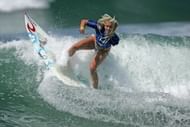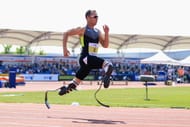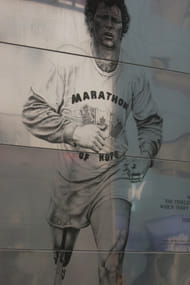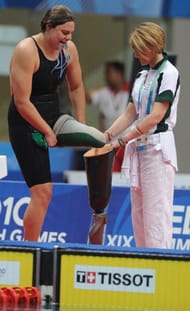Be it the past or the present, there have been numerous examples of sportspersons finding unexpected success. This could be attributed to sheer luck, out of the box thinking in complex circumstances, or strong belief and consistent hard work. Occasionally, fate also throws up some inexplicable tales, like that of Orissa’s child prodigy, Budhia Singh.On the other side, there have been stories of people who cheated their situation, on a consistent basis. These athletes overcame disability, and in the process, became role models for the like across the world. They made such special people truly believe in the truth of Adidas' tag line 'Impossible is Nothing'.Here’s a list of a few successful disabled sportspersons (in no specific order, because, to rank them based on personal knowledge or opinion would be an action of disrespect).
#5 Bethany Hamilton

Bethany lost an arm due to a freaky incident. At the age of 13, she was bitten by a shark while surfing at Kauai. But within three weeks of treatment, she was back in the water. Throughout her career, mostly in the Americas, Hamilton has won up to 15 national level surfing championships.
The movie ‘Soul Surfer’ was inspired by her story.
#4 Martin Hofbauer

The Austrian holds the distinction of being the first amputee footballer. Like Terry Fox, he had to lose a leg below the knee due to cancer. In May 2013, he was permitted by FIFA to compete with able bodied athletes. He shares his story here.
#3 Oscar Pistorious

When it comes to discussing disability, the name Oscar Pistorius instantly comes to mind. The South African had both his legs amputated (below the knees) even before he completed a year. Despite the early setback, he was an active player of rugby, water polo and wrestling at the junior level. He took to running in 2004, after a serious injury while playing rugby. After experimenting with a variety of manufacturers for his blades, he finally settled on the Icelandic brand, Ossur.
In the 2004 Paralympic Olympics, he set a 200m world record and successively broke his own records in 2005 and 2006. By the summer of 2007, he held world records in 100m, 200m and 400m for disabled athletes. Oscar was aiming to compete among able bodied athletes in the Beijing Olympics (2008), but sadly, he wasn’t allowed.
There were claims from rivals and authorities that he was gaining an unfair advantage with his artificial limbs, and a series of tests were carried out in late 2007. It was believed that Pistorius had a good chance of making it to South Africa’s 4x100m relay team. However, he was just falling short of the required eligibility time. A tangle between the Organizing Committee and the South African Olympic Committee followed, but ultimately, they were of the opinion that he wasn’t quick enough. Even when quizzed on the prospects of a wildcard, Pistorius was of the opinion that it wouldn’t be worth accepting, because, he wasn’t quick enough.
He would still go to Beijing though, for the Paralympics. There, he again won 3 gold medals in 100m, 200m, and 400m.
During 2011, Pistorius beat the cut-off time in 400m to gain the qualification mark for the Olympics. Finally, he was included in the South African contingent for the London Olympics (2012). He became the first amputee to participate in able-bodied Olympics. Facing the odds, he had finally made it.
Said Erik Wayhenmayer (the first blind man to climb Everest), in 2012, “Pistorius has engineered a paradigm shift, in which disability becomes ability, and disadvantage becomes an advantage“.
Pistorius has competed in 100m, 200m, 400m and 4 x 100m relay at the Paralympic level, and the latter two at the able-bodied level.
Pistorius won the ‘Laureus World Sports Award for Sportsperson of the Year with a Disability’ in2012, and was even conferred a doctorate degree by the University of Strathclyde (Glasgow).
Here are some words of inspiration, his motto – “You're not disabled by the disabilities you have, you are able by the abilities you have.“
Sadly, the ‘Blade Runner’ has been in the news for all the wrong reasons in recent times. It is unfortunate to see such an inspirational figure caught in a murder case (Pistorius is alleged to have shot his girlfriend Reeva Steenkamp) and whether or not he comes out clean, his legacy will always be tarnished by this serious off-track infraction.
#2 Terry Fox

Born in 1958, Terry Fox was a school level athletics, soccer, rugby and basketball player. Despite standing just five feet tall, his passion was for the latter, but he decided to take up running instead, on the advice of his coach.
In 1976, Fox crashed his car and injured his knee. He played through the pain for a whole year,until he was diagnosed with osteosarcoma, a form of cancer starting from the knees. Owing to medical advancements at the time, doctors estimated his chances of survival at fifty percent. His left leg was amputated, and he had to take chemotherapy treatment.
To stay fit and reduce the intensity, he took to golf. Walking on artificial limbs, he was impressed with cancer research and devoted more time towards visiting patients. He felt he owed something to the medical research which had prolonged his life. He was saddened by how little money was devoted towards cancer research, and planned to run across Canada to raise money and create awareness.
Fox participated in a marathon in British Colombia and finished last. It was there, where he revealed his plan. Though his mother disapproved of it, his persistence paid off, and in October 1979, he started the groundwork for his journey.
Fox made the Canadian Cancer Society aware of his run, and obtained certifications from heart specialists. A running leg (prosthesis) was bought, and essential items were sponsored – a support van from Ford, and running shoes from Adidas. In April 1980, he was off.
By June, having completed 8 thousand kilometres, the run had raised $200,000. Near Montreal, he found the person who would be his biggest monetary backer – businessman Isadore Sharp. Sharp had lost his own son to cancer, and hence took personal interest in Fox. The runner was offered service at all his hotels throughout his run. Sharp donated 2 dollars for every mile Fox ran, and challenged his peers.
He continued his run into Ottawa and Toronto, and it is believed, on one day alone (in Toronto), he received donations worth $100,000. Ignoring frequent knee pain, dizziness, and tendonitis, he continued well into September, by which time, he had reached Thunder Bay. There, he was forced to end his remarkable run, because his cancer had spread to his lungs. He had covered 5000 kilometres. The donations stood at $1.7 million. Later, a five hour television program alone raised more than $10 million towards his cause!
On June 28th, 1981, he breathed his last. In his memory, said Canada’s Prime Minister: “It occurs very rarely in the life of a nation that the courageous spirit of one person unites all people in the celebration of his life and in the mourning of his death. We do not think of him as one who was defeated by misfortune, but as one who inspired us with the example of the triumph of the human spirit over adversity“.
Post his death, Sharp kept up the efforts and encouraged people to participate in fundraising runs. Six years since his death, the runs had raised $20 million. It soon became a worldwide event. Awareness about this fundraising campaign has reached India as well.
As of today, more than $600 million has been raised under the ‘Terry Fox run’. Braving cancer and the loss of a leg, Fox’s story is one of dedication, gratitude, and a never-say-die attitude.
#1 Natalie du Toit

This South African began swimming at the age of fourteen. Unfortunately, a couple of years later, her left leg had to be amputated after a road accident.
The 2002 Commonwealth Games was her breakthrough event. Aged 18, she set the multi-disability world record in 50m and 100m freestyle and also qualified for the 800m freestyle able-bodied final. She was recognized as the Outstanding Athlete of the Games.
Though she missed out on competing with able-bodied swimmers in 2004, she achieved it in 2008. Natalie managed to finish the 10km freestyle race in 16th place. In the Paralympics that year, she also won five gold medals.
Natalie retired from competitive swimming at the end of the London Olympics, 2012, having won more than 30 medals in various competitions throughout her career.
“I don’t think of myself as being disabled, or able-bodied. Going out there in the water, I feel there is nothing wrong with me”, she says. That’s how you define positive attitude!
All these athletes shared a common vision – to be able to be considered able enough to compete against abled-ones. They didn’t want to be looked at with a sorry face. They refused to acknowledge anything wrong with the way they were. Instead, they became inspirations for others sharing the discomforts as them.
Such tales make us truly appreciate the gift of four limbs that God has given us. For the not so fortunate ones, they also show that all is not lost; there is enough reason for optimism.
